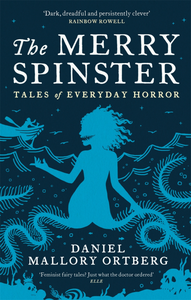You need to sign in or sign up before continuing.
Take a photo of a barcode or cover
Very fun! You have to be very well versed in folk tales/pastoralist children's literature and/or already be all in on Lavery's particular voice to fully enjoy it, but I got a good few of the references and love everything he's every written beside, so this worked very well for me. Can't wait for Women's Hotel.
This is exactly the kind of book that should be right up my alley. I enjoy retellings of familiar stories, especially when they are given a dark and grim twist. Yet, I found myself disappointed by this collection of short stories. In many cases, the stories seemed to just end and there wasn't much of a point. And it was hard to tell why the author felt a need to retell this particular story in this way. The Velveteen Rabbit story was perhaps the best one in this collection. It was dark and creepy and weird and somber and the tone was just right. There were a couple of other stories that I also thought were well done. The rest, however, were disappointing. I really wanted to like this. I'm sad that I didn't like it more.
Disturbing, clever, and elegant, reminds me of Shirley Jackson and Neil Gaiman. Ortberg at his uncanny best.
Out of all of the stories only 2 made sense. All do these stories had terrible endings that only left me confused. Was that the point? Very disappointed.
Creepy good fairy tale twists! The Velveteen Rabbit, dear Lord, about did me in. Greater collection of short stories.
I received a free copy of this book from NetGalley
This was a really great book of fairytale retellings. I like how she often took inspiration from more than one story at a time [all the source stories are listed at the end of the book] instead of just doing a straight retelling but with dark elements added. It definitely helped keep my interest because I didn't always know where the story was going, which I find is the problem with a lot of fairytale retellings these days. These are definitely darker than the Disney versions you are probably familiar with and also have a lot of feminist undertones that set them apart from the originals as well. There were a few at the end that I wasn't as into, but for the most part these were very enjoyable.
This was a really great book of fairytale retellings. I like how she often took inspiration from more than one story at a time [all the source stories are listed at the end of the book] instead of just doing a straight retelling but with dark elements added. It definitely helped keep my interest because I didn't always know where the story was going, which I find is the problem with a lot of fairytale retellings these days. These are definitely darker than the Disney versions you are probably familiar with and also have a lot of feminist undertones that set them apart from the originals as well. There were a few at the end that I wasn't as into, but for the most part these were very enjoyable.
As someone who lives for fairy tale retellings, I was very excited about this book. I thoroughly enjoyed these revisions of classic tales. I can't say I understood all of them (those that I didn't "get" were very few in number), but I still enjoyed the experience of reading them. My favorite stories in the collection were "The Merry Spinster" and "Six Boy-Coffins." Ortberg does a great job of bringing out darker themes from the original stories in these new versions.
the daughter cells- 4/5
the thankless child- 2/5
fear not: an incident log- 1/5
the six boy-coffins- 3/5
the rabbit- 4/5
the merry spinster- 1/5
the wedding party-1/5
someone's been threatening our friend mr. toad- 1/5
cast your bread upon the waters- 2/5
the frog's princess- 1/5
good fences make good neighbors- 1/5
the thankless child- 2/5
fear not: an incident log- 1/5
the six boy-coffins- 3/5
the rabbit- 4/5
the merry spinster- 1/5
the wedding party-1/5
someone's been threatening our friend mr. toad- 1/5
cast your bread upon the waters- 2/5
the frog's princess- 1/5
good fences make good neighbors- 1/5
I really enjoy Ortberg’s voice and writing. The stories are excellent individually but feel a little repetitive as a collection.
I liked The Rabbit and, Fear Not, and Six Boy Coffins
Each story was a snapshot into the larger world of one. There were no resolutions and sometimes no real plot or point. It felt like she either got bored and/or just didn’t feel like finishing the tales. Maybe possibly she backed herself into some storytelling corner she didn’t know how to get out of so she just stopped writing so as not to expose that. I’m not sure which, but mostly I’d get to the end of the story and scratch my head.
She can write that’s for sure. She’s got some great sentences in there. It could be over the top, for example the “witty” banter of The Wedding Party” was so excessive I found myself wondering how anyone could have the energy to match that conversation. It was relentless.
The gender pronoun swapping felt contrived. As if to say “I’m inclusive...I’m mixing it up.” There was no real-ness to it. More like it was used to check an LGBTQ genre box. It’s possible it was used to make use of preconceived notions of what is expected of daughters as opposed to sons in fairy tales. So making daughters—He—thereby causing the reader to assign those duties to the male character instead. It really only worked well in The Frog’s Princess.
So much gaslighting! In numerous stories. Hit too close to home.
Each story was a snapshot into the larger world of one. There were no resolutions and sometimes no real plot or point. It felt like she either got bored and/or just didn’t feel like finishing the tales. Maybe possibly she backed herself into some storytelling corner she didn’t know how to get out of so she just stopped writing so as not to expose that. I’m not sure which, but mostly I’d get to the end of the story and scratch my head.
She can write that’s for sure. She’s got some great sentences in there. It could be over the top, for example the “witty” banter of The Wedding Party” was so excessive I found myself wondering how anyone could have the energy to match that conversation. It was relentless.
The gender pronoun swapping felt contrived. As if to say “I’m inclusive...I’m mixing it up.” There was no real-ness to it. More like it was used to check an LGBTQ genre box. It’s possible it was used to make use of preconceived notions of what is expected of daughters as opposed to sons in fairy tales. So making daughters—He—thereby causing the reader to assign those duties to the male character instead. It really only worked well in The Frog’s Princess.
So much gaslighting! In numerous stories. Hit too close to home.



